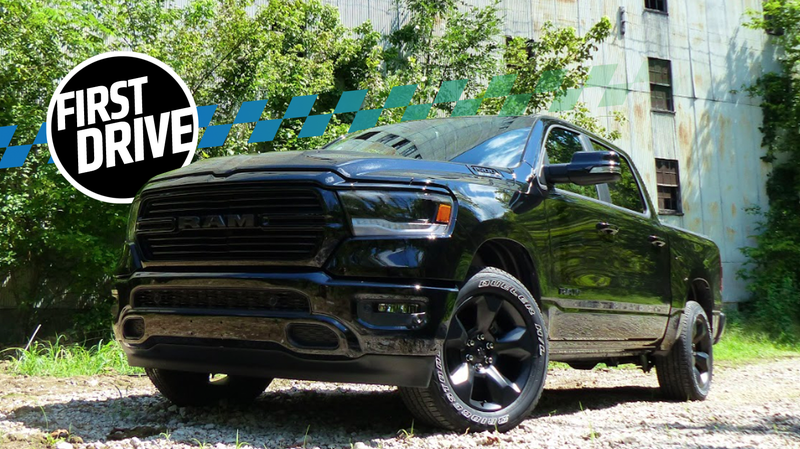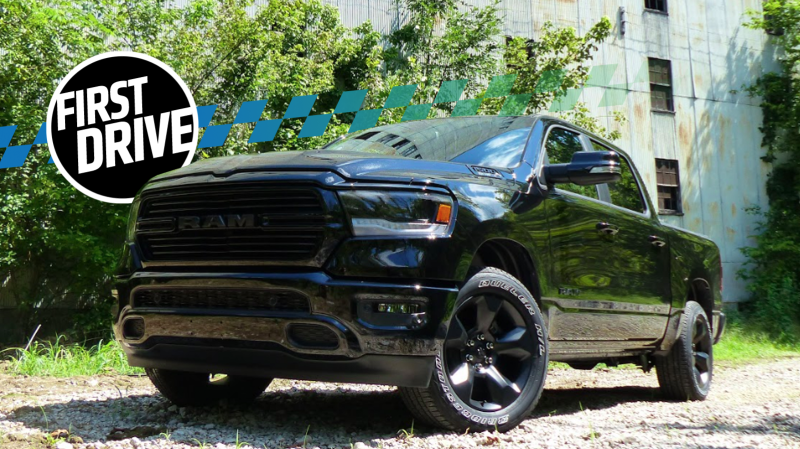
 Jalopnik ReviewsAll of our test drives in one convenient place.
Jalopnik ReviewsAll of our test drives in one convenient place.To meet fuel economy and emissions standards, more automobiles than ever are becoming electrified, and that includes pickup trucks. But should diehard truck drivers be worried about a technology that many associate with small economy cars? Based on my short drive of the 2019 Ram 1500 hybrid, the answer is no.
(Full Disclosure: Fiat Chrysler Automobiles flew me to Lexington, Kentucky, put me up in a fine hotel, and fed me barbecue—all just so I could drive the 2019 Ram 1500 mild hybrid. It’s also worth mentioning that prior to my time here at Jalopnik, I worked as an engineer for FCA and made minor contributions to the development of the Ram’s mild hybrid system.)
The all-new 2019 Ram 1500’s two stand-out features when it debuted at the Detroit Auto Show in January were the huge 12-inch infotainment screen and the new 48-volt mild hybrid powertrain. My coworker Andrew had a chance to experience the former when he drove a non-hybrid 5.7-liter Hemi V8 model a few months back (he was a fan), but he was left “eager to see what the eTorque hybrid V6 can do.”
Yesterday, I spent a day behind the wheel of both the 3.6-liter mild hybrid truck and the 5.7-liter mild hybrid, and while I can’t say I found the 48-volt system to offer much improvement compared to a conventional truck, I can say that it was mostly seamless and didn’t ruin the pickup truck experience. So if you were worried about that, don’t be.
What It Is
Advertisement
The Ram 1500 is all new for 2019, and includes a number of new technical features that director of Ram engineering Rob Wichman enumerated in his interview with us a few months ago. But since we’ve already tested the standard truck, today we’ll focus only on the hybrid system.
Fiat Chrysler calls the system “eTorque,” and it consists of a small, air-cooled 48-volt, 430 Watt-Hour lithium-ion battery pack mounted in the cab behind the rear seats; a Motor Generator Unit, or MGU, that replaces the alternator on the internal combustion engine’s front end accessory drive; and a DC to DC converter that allows the 48-volt battery to charge the 12-volt battery and power the vehicle’s accessories.
Advertisement
The purpose of the system is to reduce vehicle emissions and to increase fuel economy, but Ram claims that the setup offers significant drivability benefits, as well.
We’ll start with fuel economy: The 5.7-liter mild hybrid Ram scores two MPG higher in EPA city and combined fuel economy over the available non-hybrid V8 truck. FCA says the mild hybrid system is expected to yield an approximately two to three miles per gallon increase in city and combined fuel economy for the 3.6-liter truck as well, when compared to the last generation V6 model (the new “DT” Ram comes standard with eTorque on V6 models).
Advertisement
Some of that fuel economy benefit comes courtesy of a start-stop system that Ram says can keep the engine off for as long as 10 minutes thanks in part to the 48-volt battery pack’s ability to assist with the vehicle’s 12-volt electrical loads that would otherwise deplete the standard battery with the engine off. More engine-off time means less fuel burned (Ram says an hour of engine-off time can save a half a gallon of gas).
Another part of that fuel economy benefit is regeneration, which occurs during coasting or braking, and which involves the vehicle’s wheels spinning the engine through a locked torque converter. That then turns the eTorque machine—the MGU—on the accessory drive, which acts as a generator to charge the 48-volt battery.That juice can then be strategically depleted (during cruising, for example) to, for a short time, accommodate the vehicle’s 12-volt loads, reducing parasitic drag on the engine associated with the MGU’s alternator function.
Advertisement
From a drivability standpoint, another thing that the 48-volt battery’s juice can be used for is cranking the electric motor up after an autostop event. Fiat Chrysler says the V6’s Motor Generator Unit can produce up to 90 lb-ft of torque, while the V8’s MGU can make 130 lb-ft.
This torque, which is not additive to the combustion engine’s overall figures (the V6 makes 269 lb-ft, the V8 makes 410 lb-ft), is used to quickly crank the engine over when a driver pulls away from a stop light. That torque, along with an electric oil accumulator that preps the transmission to drive even when the engine is off, apparently allows the truck to launch within 400 milliseconds of the driver releasing the brake pedal.
Another drivability benefit, Ram claims, is that the electric motor can smooth transmission shifts by dragging the engine speed down during upshifts (in this case, the MGU is being spun by the engine and generating power for the 48-volt battery) and by adding torque to the engine (in this case, the 48-volt battery powers the MGU to turn the engine) to help spin it up during downshifts.
Advertisement
Ram says that how quickly the “start” part of the stop-start event happens depends on pedal input, with the MGU changing its torque applied to the engine accordingly. In addition, the MGU also applies torque as the engine shuts down to help smooth the shut-off process. (The top plot above shows actual engine RPM versus time plotted against “ideal” engine RPM versus time; The MGU’s torque application used to bring the two curves as close as possible—and thus to smooth out engine stop events—is shown in the lower plot).
In other words, the system promises to not only seamlessly improve vehicle fuel economy, but it also promises cleaner transmission shifts.
Advertisement
What’s Great
The things that make the regular non-hybrid Ram 1500 so solid are largely unaffected by the mild hybrid system. The ride is still decent, the infotainment screen is still monstrous and good, and the interior itself is still perhaps the best in all of pickup truck-dom.
Advertisement
The 395 horsepower 5.7-liter V8 still makes a great noise, and moves the truck along with plenty of vigor, the rear cabin space is still enormous despite the battery pack behind the rear seats, and of course, the good looks have gone untouched.
Advertisement
I spent hours driving the V6 and V8 eTorque hybrids on the rolling hills of Kentucky, looking for strange drivability issues that the integration of the mild hybrid system might have introduced. For the most part, I found the system to be seamless.
Stop-start was fairly smooth, with the engine shutting off when the truck came to a halt, and the MGU quickly and harmoniously firing that engine back up to accelerate the truck from a stop.
Advertisement
I not only towed a trailer, but I quite frequently hammered on the gas pedal like a jackass, and the truck took off like it should, and made all the right sounds. In other words, the hybrid powertrain doesn’t soften the grunt of that 5.7-liter motor or of the 3.6-liter (which, at 305 horsepower, wasn’t slow, but definitely spent a lot of time high in the rev range when I drove it).
In many ways, both the 5.7-liter and 3.6-liter hybrids behaved quite similarly to their non-hybrid counterparts from the previous generation truck.
What’s Weak
Advertisement
Every 3.6-liter DT Ram must be optioned with the mild hybrid system, and that means you get to lug around 105 pounds of extra weight, plus you get to deal with the loss of packaging space (which could make repairs more difficult), and you’ll have to deal with whatever servicing comes with maintaining a liquid-cooled MGU and an air-cooled lithium ion battery pack.
(The 5.7-liter, though, can be optioned without the hybrid system, which only adds 90 pounds since the V8’s MGU is air cooled. Not opting for the hybrid version of the V8 also brings the price down by $1,450).
As far as the drivability benefits of the system, I can’t say I really noticed them in my short time driving the truck. If anything, the only true benefit was the seamlessness of the start-stop events, but I haven’t really paid attention to how a regular non-hybrid Ram handles those, so it’s hard for me to really quantify that. Otherwise, the shifts really didn’t seem any better, and in fact, the downshifts were sometimes a bit firm.
Advertisement
Again, I’ll admit that I had to pay careful attention to notice any strange sensations from the system, but while stepping on the brake, I noticed the downshifts were definitely not as refined as they could be—not terrible, but it was occasionally noticeable. Whether that’s the fault of the hybrid system, I’m not entirely sure, but it seems like there’s still a bit of tuning that can be done, there.
Early Verdict
Advertisement
It’s hard to make any strong conclusion on the Ram 1500 eTorque, because one of the main promises the system makes—and undoubtedly the one that customers care most about—is fuel economy. And while I can point at EPA fuel economy figures all day, the reality is that real-world fuel economy numbers don’t always match up.
And during my six hours behind the wheel, there simply wasn’t enough time, nor were the right driving conditions in place, to truly determine how much better gas mileage the mild hybrid system adds. This is an especially important point to make because the system didn’t seem to offer a significant benefit in terms of vehicle drivability during my short time testing.
In addition, I couldn’t assess overall durability and longevity of the system in my short test, and that’s certainly something truck buyers care about. So whether the system will be reliable enough and offer a sufficient fuel economy gain to be worthwhile to pickup truck customers—that’s still up in the air.
Advertisement
Of course, these caveats apply to all new vehicles. And I will say that if, in the real world, the hybrid system really does offer the over 10 percent improvement in city and mixed fuel economy that the EPA’s rating suggests, then this hybrid system seems well worth the cost and weight, particularly because the 3.6-liter eTorque can allegedly carry up to 2,300 pounds in its bed, and the 5.7-liter mild hybrid can tow up to 12,700 pounds.
It seems like the Ram’s truckishness made it through the hybridization process unscathed. The Ram 1500 eTorque, to me, didn’t feel much different than driving a regular Ram pickup, and that’s a good thing.















